#(and another good omens themed farm that i share with a friend)
Text

using the signs in the 1.6 update as intended
#original post#sdv#stardew valley#1.6 update#in case youre wondering this farm is ayda aguefort#after making#an adventure zone themed farm#a monster factory themed farm#a farm exclusively for being in a lesbian relationship with Leah#a star trek themed farm#and a good omens themed farm#(and another good omens themed farm that i share with a friend)#i decided it was time for dimension 20 to have its time in the sun#1.6 spoilers#i guess?
185 notes
·
View notes
Note
Hello! I have a question.... what are your favorite books, and why? (I love your blog!)
@smallricochet
Wow, thank you! Took me forever to reply because my first answer got erased when i was halfway through. Rawr. anyway, here’s the thing: i don’t have favorites. I just love books so much i can’t choose! And there are books for different moods, too, or books that i love for different reasons. There are those that i can read anytime because they’re friendly and easy to sink into, but aren’t necessarily the best of anything in a particular aspect. There are books that i have to be in a specific mood to read but that i love more than anything when i am in that mood. There are books that are outstanding in one thing and lacking in another…so i don’t have favorite books, and when i have to think of my favorites, they’re divided by genre. This is gonna be a long post, haha. Without my bookshelf in front of me, there may be some I’m forgetting, but those are the ones that stand out in immediate memory.
Fantasy: most of the books i’ve read would probably count as fantasy if you included YA, but i’m going to break out YA as its own thing because i look for different things now than i did when i was younger. For one thing, the writing style plays a much larger role now for me, which is one of the things that makes Neil Gaiman one of my favorite authors. American Gods is this gorgeous book examining the nature of belief, with such evocative language that i felt like i was taking the journey alongside the characters. The characters themselves are rather stock, but that’s okay–Gaiman has a true sense of the mythic and interweaves old stories with new in a way that captivated me. I also loved The Ocean at the End of the Lane, which just felt…almost more real than our own world. I read the book (it’s quite short) in one sitting, and when i finished i realized i’d teared up. There’s a scene where the main character is immersed in this experience of understanding everything and then is pulled out of that state, and i felt the same way upon closing the book. The sense of the world-beyond-our-world was intense–again, taking the journey with the characters. I adore Good Omens, which was co-written with Terry Pratchett, and i think combines the best of both authors: Gaiman’s sense of mythology, Pratchett’s humor, and their shared love for stories that examine the values individual people hold. Individual values are a theme often repeated in Pratchett’s books, of which my favorites are Hogfather and Thud! because of the beautiful, hopeful characterizations and complex conflicts. Pratchett’s books really carry this sense of optimism and hope for how much better we can be; his characters have this evolving humanity (lol some of them are dwarves and trolls and werewolves) that really strikes a chord with me. Also, those books are fucking hilarious.
I’ve written about Guy Gavriel Kay recently; his novel Under Heaven is remarkable for its beautiful language, fascinating characters, and exciting political plot. I love that niche–historically-based political fantasy–and am really relieved to have found someone besides George R. R. Martin who does it, since Kay is much subtler and doesn’t have Martin’s penchant for shock and gore. I’m about to read every other political fantasy novel Kay has ever written. I used to think that if i could write like anyone i’d want to write like Gaiman, but now that i’ve read Kay’s work, i’d rather write like him, because that’s the genre i’d want to succeed in.
Then there’s Susanna Clarke’s exquisite Jonathan Strange & Mr. Norrell. I know this is very much a love-it-or-hate-it book, and i love it. Actually, i think it’s a perfect novel. I would change nothing about that book; there’s nothing that could make me like it better. The descriptive visual language is rich and flowing, the dry humor is just right, and the mythology she builds is original and forms a perfect pattern. One of the things that stood out to me the most in the book are the names. I’ve never seen an author choose names like her–they’re all lyrical and evocative without being literal. I don’t even want a sequel because the plot is wrapped up perfectly; i just want a whole series set in that world. (Clarke also wrote a short story collection in that setting, The Ladies of Grace Adieu, which is excellent, but does not fulfill my desire for a million more full-length novels.)
Historical fiction: The Lymond Chronicles. This is a masterwork, to the point that the author, Dorothy Dunnett, was knighted for her books being such a huge contribution to UK culture. They’re hard to read, no denying that, but they are unparalleled for incredible descriptive language, depth of emotion, dexterity with shifting viewpoint, epic scope, characters’ journeys and personalities interwoven in fascinating ways…they so far outshine every other work of historical fiction i’ve read that i think i can say that series is my favorite. HOWEVER, the irony of it is, i have never reread those books, except the first. I flick around occasionally to reread passages, but they’re simply too dense to make for good light reading in between all my new reading material. I love Les Miserables too, in the sense that i think it’s one of those almost accidental masterpieces that would never make it to market in full form today. Victor Hugo was a mystic grandpa whose interest in architecture/public infrastructure reeeeally got in the way of his own plot. I can’t HELP but love that book and i don’t even know why, except that Hugo captures the emotions and complexities of youthful rebellion so well, and is deeply respectful to the tragedy of it–not flippant, not over-aggrandizing, but accepting in just the right way. I also wanna give a shoutout/honorary mention to Romance of the Three Kingdoms. (It’s sort of unfair to put it with historical fiction, given the part where a guy’s ghost wanders around beating people up, but like. What else do i call this book.) I mean, it’s not my usual fare, but it well deserves its place as one of China’s four great classics. It’s so different from modern writing, which places a lot of emphasis on knowing individual characters. Three Kingdoms doesn’t give a shit about the inner lives of the characters. This is a story about how empires are formed and fall. it’s a true epic, and a fascinating look into one of China’s most tumultuous historical periods. (most tumultuous, except for all the others. You do you, China.)
Nonfiction: I’ve only rather recently become interested in nonfiction, and most of what i like is just a combination of good writing style and a topic i’m specifically interested in. How Not To Be Wrong, by Jordan Ellenberg–applied math and statistics, written in a very fun way. The Disappearing Spoon and The Violinist’s Thumb, by Sam Kean–a history of the periodic table and genetics respectively; Kean is such an engaging writer and really knows how to draw a common thread through anecdotes. Fermat’s Enigma, by Simon Singh–a history of the quest to solve Fermat’s Last Theorem. Weapons and Fighting Arts of Indonesia, by Donn Draeger–uh, what it says on the cover, but also a very interesting cultural text, although the info is a bit out of date. Walking the Bible, by Bruce Feiler–Feiler travels through the Middle East, examining the historical context of biblical stories; i’m reading his other works now. There also have been a couple books i’ve read for school that i loved–one was a cultural study of Hello Kitty, of all things, and one was about coffee farming in Honduras. Both were for a globalization course, but i can’t remember the titles offhand. I also read Walkable City by Jeff Speck for urban studies, about the importance of building walkability into your urban planning, which kicked off an interest in urban planning for me. I wound up getting three other urban planning books out of the interest generated by that one.
YA: Most of the books that have stuck with me after i read them as a teen had characters i wanted to be friends with or that i strongly related to–books with a lot of analytical, assertive girls, or girls who loved stories and were very imaginative. These include Anne of Green Gables by Lucy Maud Montgomery, the All-of-a-Kind Family series by Sydney Taylor (bonus points for multiple girls i related to and they were Jewish), The Penderwicks by Jeanne Birdsall (again bonus points for multiple girls i related to), Ella Enchanted by Gail Carson Levine, and The Princess Academy and The Goose Girl by Shannon Hale. These last three (modern takes on fairy tales) mattered so fucking much to me, and they seriously hold up on rereads. Hale and Levine don’t protect their readers from harsh events, but it’s still fantasy, still has the magic i love reading about. They show the young characters win magical battles and friendship through intelligence, creativity, and determination, instead of beauty like the original tales, so that was really inspiring for me, and i related really hard to the main characters personality-wise. All three main characters in these books do find relationships or even marry at the end, but it’s because they’ve already been best friends with their love interests for a while. There’s also The Hunger Games, which had fascinating characterization, and unusually subtle morality for a YA series, especially in the last book, and the similarly adventurous Icemark Chronicles series by Stuart Hill, which is historically-based fantasy–think Guy Gavriel Kay for younger readers–with a wonderful main character that i really looked up to. And then there’s The Pushcart War, by Jean Merrill. The Pushcart War is just completely charming. It’s a friendly, quick-read book about a group of pushcart vendors trying to make space for themselves in New York City, opposing the aggressive truckers, and it was just plain fun while also being…actually pretty educational about urban design.
So…i know that’s super long, but y’know, asking me about favorite books is a dangerous thing to do. And i can’t emphasize enough that this is only what i can think of off the top of my head, without my bookshelf in front of me. But thank you so much for the question!
5 notes
·
View notes
Photo

New Post has been published on http://www.classicfilmfreak.com/2017/04/06/flim-flam-man-1967-starring-george-c-scott-michael-sarrazin-sue-lyon/
The Flim-Flam Man (1967) starring George C. Scott, Michael Sarrazin and Sue Lyon
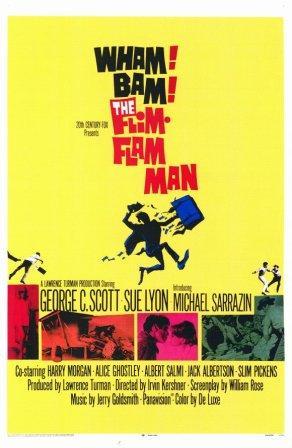
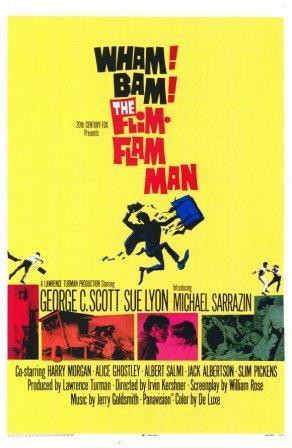
“Our experiences today suggest that the territory is ripe for exploitation—you know the territory, and . . . er . . . I know how to exploit.” — Mordecai to Curley
Among its other attributes, 1967 has the odd distinction of featuring at least four films set in the rural South. There’s the Georgia chain gang in Cool Hand Luke (filmed in California), two gangsters rampaging across Texas during the Great Depression ’30s in Bonnie and Clyde (actually filmed in Texas), racial bigotry toward a stop-over black police detective in Mississippi in In the Heat of the Night (filmed largely in Illinois) and traveling con artists in an unspecified Southern backwater in The Flim-Flam Man (filmed in Kentucky).
The first three films won at least one Oscar—respectively, Supporting Actor for George Kennedy, Supporting Actress for Estelle Parsons and Best Actor for Rod Steiger. In the Heat of the Night had the most wins, including Best Picture.
Perhaps because it was too much a comedy, bordering on the slapstick at times (comedies typically fare poorly at Oscar handouts), The Flim-Flam Man received nary a nomination—not for George C. Scott’s wily performance, nor for Jerry Goldsmith’s folksy score, the film’s two outstanding features, aside from its contagious, beguiling fun.
The movie has other positives: cinematography by Charles Lang (eighteen Oscar nominations, one win) and film editing by Robert Swink (Roman Holiday, The Boys from Brazil). Tight editing is, of course, essential in The Flim-Flam Man, juxtaposing and blending the slapdash action with the quiet, conversational moments of respite, where two traveling con artists share their philosophies and views on the foibles of the human condition.

The series of setups for the many unsuspecting dupes, “marks” or “pigeons” as known in the charlatan trade, are at the heart of the movie and form its theme, the gullibility and greed of mankind.
Early in the film, two newly acquainted drifters find a place for the night in an abandoned, overturned railroad caboose. The elder of the two, Mordecai Jones (Scott), tells his rescuer and future partner (Michael Sarrazin), “Greed’s my line.” Then he clarifies himself: “Only cheat the cheaters, boy—you can’t cheat an honest man.”
Later in the film, after countless revelations of their fellowman’s avarice, young Curley, AWOL from the U.S. Army, will say, “I’ve been a-wondering if there’s such a thing left in this whole world as one, plain honest man. . . . I said most people are honest enough. Every single time, you show me what they is (sic) really like.”
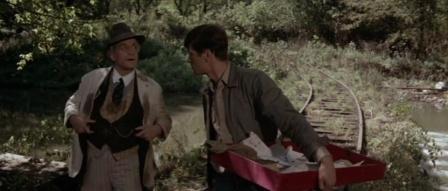
But to backtrack to the very beginning of The Flim-Flam Man. Curley, obviously on the run, climbs aboard a passing freight train. Just before swinging up into a box car, he sees a man and suitcase being thrown from the box car ahead of him. In the first sign that Curley is more charitable than Mordecai will prove to be, he drops off the train to assist the elderly man. He helps him up, aids in collecting the scattered contents of the suitcase and the two wander off, together, through the woods.
After spending the night in the caboose, the two visit a general store. Mordecai performs the old three-card monte, moving the playing cards before a sucker who must pick the queen of hearts to win. With Curley working as the shill, the two are able to take the store owner (George Mitchell) for $42.

Back at the caboose, Mordecai and Curley are enjoying their profits when their repast of salami and ham sandwiches is interrupted by angry men from the general store. Now back on the road, the two continue their scams, “getting to know” the local folks—and exposing their avarice in the process.
Next comes Mordecai and Curley’s biggest scheme, the centerpiece of the film, with its many nuances and extensions. Posing as a parson with his young friend, a car accident “victim” in need of a hospital, they steal a red convertible from a young girl, Bonnie Lee (Sue Lyon), and her mother (Alice Ghostley). “Well, I declare,” the mother says. “If the clergy ’round here’s gonna start stealin’ ever’body’s au-to-mo-bile——”

The county sheriff “Zeb” Slade (Harry Morgan) and his deputy Meshaw (Albert Salmi) recognize the red car whizzing by and give chase. Mordecai at the wheel manages to leave the nearby town in shambles, even smashing into Bonnie Lee’s father’s (Jack Albertson) new Dodge. “Yep, I’d say they’ll remember us in Clayton,” Mordecai muses.
On foot again after the convertible crashes, and still pursued by the cigar-smoking sheriff and Meshaw, the two happen upon Doodle Powell’s (Jesse Baker) moonshine still and steal, this time, his 1948 Ford pickup. When the dirt road ends at a railroad track, Mordecai has Curley deflate the truck’s tires to half pressure and, wedging the truck on the rails, they are off down the track. This way of “making tracks,” as Mordecai brags, lasts only so long—until, faced with an approaching train, they initiate a quick right turn.
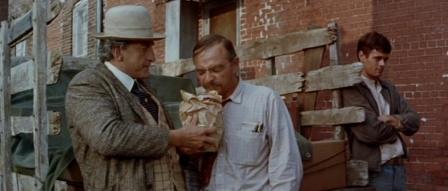
Next stop, at a general store Mordecai buys a few items, and affecting a German accent, dupes the proprietor (Woodrow Parfrey) into paying his bill with the fifty-eight bottles of whisky from the back of Doodle’s truck, adding bourbon to the sample bottle. Between the cost of Mordecai’s purchases and that of the moonshine, the owner owes $37.60.
At another store, Mordecai sells the manager (Strother Martin) a $1 punch-board. Curley, knowing where the prize punches are, follows behind and wins $20, but the pièce de résistance of the scams is the “found wallet” ploy, known in the trade as the pigeon drop. With distraction and slight-of-hand, Mordecai and Curley reap a $500 profit from their mark (Slim Pickens).
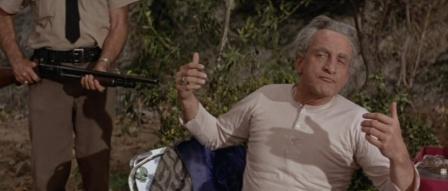
The next morning, after Curley had been to see Bonnie Lee and they have discussed a future life together, Mordecai and his partner are awakened in their woodland hideout by Slade and Meshaw, and end up in jail.
But there’s one last trick, one last scheme, one last hoodwinking of the gullible and the culmination of all Curley has learned under the esteemed tutelage of this master con artist Jones. He proves himself a worthy student. Curley pretends to inform on Mordecai, regaling Slade with lurid tales of a murderer’s career, and, with the sheriff sufficiently distracted, escapes. He returns and places stolen dynamite around the jail, and, with a plunger, threatens to blow everybody up unless Mordecai is released and given an escape car. When Mordecai makes the pre-arranged three-ring call to a nearby phone booth, signaling he’s safe, Curley demonstrates that the plunger isn’t wired to anything. He’s jailed again. But Mordecai hasn’t even left town: he’s across the street in the shadows, observing all.
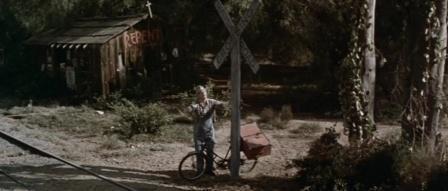
As the film began at a railroad track, so it ends at one. Mordecai, back on his own, stops at a railroad crossing and leans a presumably stolen bicycle against the wooden crossing signal. He waves as a freight train (between him and the camera) passes. When the train has passed, all that remains at the crossing is the bicycle.
To support The Flim-Flam Man, Jerry Goldsmith has evolved a score that compliments and contrasts the humor and action; as good scores must do, this one never overwhelms. Much like Bernard Herrmann, he always adjusts his orchestral makeup and tonal palette according to the mood of a given film, the musical style different from picture to picture, from the steely, percussive Seven Days in May (1964) to the modernistic, atonal Planet of the Apes (1968) to the satanic chorus in The Omen (1976).
As The Flim-Flam Man is set in the backwoods South, so harmonica, banjos and honky-tonk piano are natural additions of color. The principal theme—the first music heard—is introduced in the main title as Curley helps Mordecai to his feet, with harmonica, banjos and an orchestral stick tapping out a jazz rhythm. This folksy theme could have come out of Copland in his populist or “Americana” style, and is often set against a contrasting lyrical theme, which represents the relationship between Curley and Bonnie Lee.
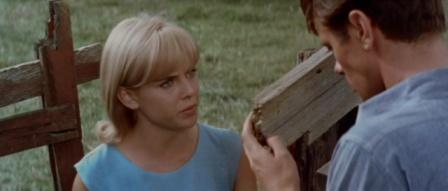
The big symphonic display comes in the frenetic, crazy car chase music—one car chase that isn’t gratuitous—where all elements are combined, even the recording of a regular piano in a lower key and speeding it up in playback to synchronize with the orchestra.
The supporting cast is all-around outstanding. Sarrazin is convincing as the young man who succumbs—but only temporarily—to the guile of Mordecai. He has a conscience. He wants to repay the damage in the two wrecked cars, plans to give himself up to the Army and later return to make his parents’ farm “a real show place.” And as he tells Bonnie Lee, “Tobacco, corn and kids is (sic) the principal crop in this county.” If a little idealistic, he is able to regain his sense of decency and, in the end, make the sacrifice for his friend and traveling companion, a sacrifice the viewer may suspect Mordecai, given the chance, would not make for Curley.
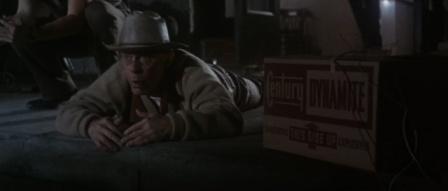
Lyon successfully moves from her roles as sexually precocious nymphs in Lolita (1962) and The Night of the Iguana (1964) to become a more innocent young girl, fervently stirred by this passing stranger. Morgan is outrageous as a hyperactive hillbilly sheriff, so good it’s easy to forget he is something of a caricature.
As for the actor who carries the weight of The Flim-Flam Man, Scott, with gray hair, bushy eyebrows and a hunched-over old man’s stance and gestures, is the clear standout. In the way he loses himself in a role and becomes entirely another person—the slick defense attorney in Anatomy of a Murder (1959), the overzealous general in Dr. Strangelove (1964) and a delusional Sherlock Holmes in They Might Be Giants(1971)—is best seen in his complete transformation into General George S. Patton in Patton (1970).
https://www.youtube.com/watch?v=DOpprrAbVcw
0 notes